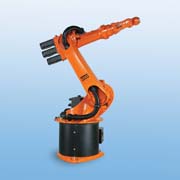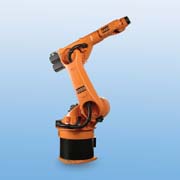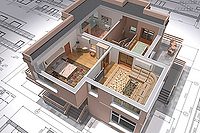
To solve this problem, a system using two six-axis KUKA robot was developed. One KR 6 six-axis robot was employed, which uses a plasma treatment to improve the adhesive properties of the plastic headlight housing. A KR 30 six-axis robotwas used to apply the adhesive.
An operator places the headlight housings on carriers, which transport them on a conveyor into the cell. Before the first station is reached, the controller monitors whether a headlight is present and, if so, whether it is the left or right headlight. A computer transfers this information to the KR 6 robot. The robot then applies the plasma treatment by using a torch nozzle to spray ionized air into the groove of the plastic component, thus increasing the surface tension of the material and enabling the adhesive to bond better.
While the carrier is moving from the plasma and bonding stations, the KR 30 robot receives a message about the type of headlight and whether it has been sprayed with plasma. If it has not, it is moved through the bonding station without further treatment. If the headlight has been sprayed with plasma, the robot applies a highly viscous, non-free-flowing two-part silicone adhesive. Filling of the groove, which is slanted in most places, can only be carried out by a jointed-arm robot with six axes. While moving about the component, the robot has to hold the nozzle of its mixing and application unit perpendicular to the bottom of the groove at all times. Otherwise, the required bead geometry would not be possible since the downward motion of the nozzle would ruin the bead.

Reinhardt-Technik found that their new automated cell provided an efficient system that not only accurately produced up to five headlights per minute, but also had the added benefit of adapting quickly and simply to changes in models. Changing the system is done by simply exchanging carriers and selecting a corresponding program. All in all, the implementation of the KUKA robots proved to be a successful project that improved quality, increased production and cut costs.
For more information, contact KUKA Robotics Corp., 22500 Key Drive, Clinton Township, MI 48036; phone (866) USE-KUKA; fax (866) FAX-KUKA; e-mail info@kukarobotics.com; or visit http://www.kukarobotics.com.
